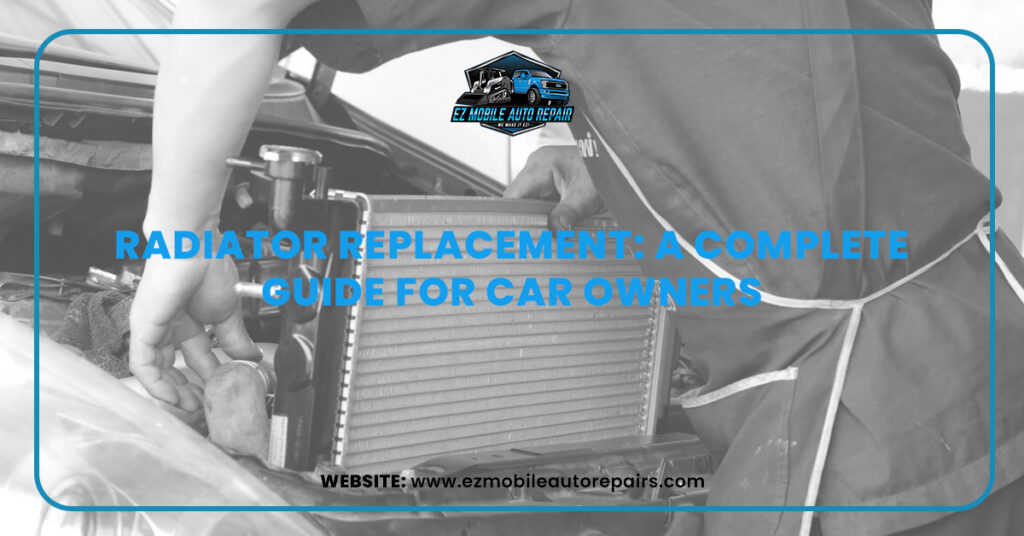
A well-functioning radiator is one of the most important parts of your car’s cooling system. Without it, the engine can quickly overheat, leading to serious damage and expensive repairs. This guide will help you understand what a radiator does, what can cause it to fail, and how the radiator replacement process works. You will also learn how to choose the right type of radiator for your vehicle and maintain it for long-lasting performance.
What is a Car Radiator and How Does It Work?
A car radiator is designed to regulate the engine’s temperature by removing excess heat. It works as part of the cooling system along with the water pump, thermostat, cooling fan, and coolant hoses.
The process begins when coolant absorbs heat from the engine as it circulates. This hot coolant flows into the radiator, which is made up of thin tubes and metal fins. As air passes through the fins, the coolant cools down before returning to the engine. This cycle repeats constantly whenever the engine is running.
Without a working radiator, the heat in the engine would rise to unsafe levels, leading to overheating and potentially causing the engine to seize or crack.
Common Causes of Radiator Leaks
Radiator leaks are one of the most common reasons for replacement. Some typical causes include:
Corrosion – Over time, coolant can break down, allowing rust to form inside the radiator. This weakens the metal and creates holes where coolant can escape.
Physical damage – Stones, debris, or small collisions can damage the radiator fins or tanks, leading to leaks.
Pressure problems – A faulty radiator cap or other cooling system issue can create too much pressure, forcing coolant out through weak spots.
Wear and aging – Seals, gaskets, and hose connections naturally wear out over time, allowing coolant to leak.
Identifying the cause of a leak early can sometimes make repair possible, but in many cases replacement is the more reliable solution.
Step-by-Step Radiator Replacement Process
If you need a radiator replacement near me, a mechanic will usually follow a process similar to this:
- Coolant removal – The old coolant is drained from the radiator into a container for safe disposal.
- Disconnection of hoses and wires – All coolant hoses, clamps, and any electrical connections are removed.
- Radiator removal – The old radiator is carefully lifted out of its mounting position.
- Installation of the new radiator – The new unit is placed into position and secured with the necessary mounts.
- Reconnection of components – Hoses, clamps, and sensors are reattached to the radiator.
- Coolant refill – Fresh coolant is poured in, and any air bubbles in the system are removed.
- System testing – The mechanic runs the engine to check for leaks and confirm the cooling system is operating correctly.
While some experienced car owners perform this replacement themselves, it is often better to have it done professionally to ensure a proper fit and to avoid mistakes that could cause overheating.
Signs You May Need Radiator Replacement
Knowing the warning signs of a failing radiator can help you act before the problem worsens. Look out for these indicators:
- Frequent engine overheating
- Puddles of coolant under the car
- Coolant levels that keep dropping despite refilling
- Rust particles or discoloration in the coolant
- Visible damage to the radiator fins or tanks
If you notice any of these symptoms, have your radiator inspected as soon as possible. A delay could lead to costly engine repairs.
Types of Car Radiators and How to Choose the Right One
There are several types of radiators available, each with unique features.
Aluminum radiators – Aluminum radiators are lightweight and corrosion-resistant, these are common in modern vehicles and offer efficient cooling.
Copper-brass radiators – Copper-brass radiators are known for excellent heat transfer, these are often found in older cars and heavy-duty applications, although they are heavier than aluminum models.
Plastic-aluminum radiators – Plastic-aluminum radiators combine an aluminum core with plastic tanks to balance weight, cost, and performance.
When choosing a radiator, match it to your vehicle’s specifications, driving conditions, and budget. Always check your car’s manual or consult with a mechanic before making a decision.
Maintenance Tips to Extend Radiator Life
Regular care can help your radiator last longer and perform better:
- Check the coolant level regularly and refill it if needed.
- Flush the cooling system every two to three years to remove rust and debris.
- Inspect radiator hoses for cracks or leaks.
- Make sure the radiator cap seals tightly to maintain proper pressure.
- Keep the radiator’s front grille clean to allow maximum airflow.
Following these steps can delay the need for radiator replacement and ensure your car’s cooling system works efficiently.
Final Thoughts
Your radiator plays a vital role in keeping your car’s engine at the right temperature. Understanding how it works, what causes it to fail, and when to replace it will help you avoid major engine problems.
If you notice overheating or coolant leaks, searching for radiator replacement near me will connect you with professionals who can fix the problem before it becomes serious. With the right maintenance, your new radiator will keep your engine cool and your vehicle running smoothly for years to come.
